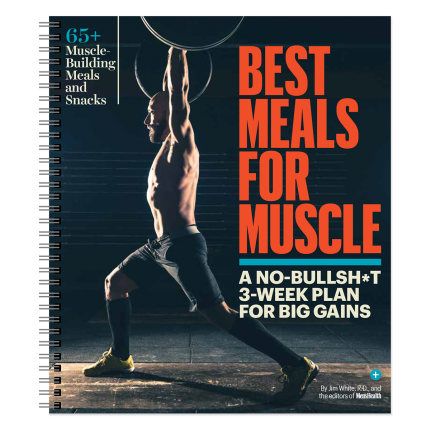Had Lots of Boost Available to Me So I Drank Muscle Gains Easy Weight Gain Calculator
Building muscle is why most of us constantly return to the gym. It's the beacon of light that continues to drive our effort-driven workouts that many consider us crazy for, but how do we build muscle effectively? That's the question that trips up so many lifters.
That's because it's harder to build muscle than you might think. Building muscle isn't simply about going to the gym, and it's not simply about eating pounds and pounds of protein. To build muscle, you must push your muscles to the limit, then let them recover and grow stronger as they do. And to do this, you must create the proper recovery environment for them when you're not in the gym.
This means your quest to build muscle involves a host of variables over a 24-hour period. The things you do in the gym to push your muscles to the limit count. So does the "work" you put in during the other 20 or so hours when you're away from the gym, everything from rest to nutrition to active recovery. All of this can affect how you build muscle.
One of the best ways to get started is to understand and define what muscle-building actually is. Muscle hypertrophy is the increase in growth of muscle cells, and it's a process that's often kickstarted by resistance training. Essentially, you need to push your muscles hard, often by lifting heavy loads for reps, stimulating the release of muscle-growing hormones and other metabolites.
Muscle hypertrophy is the adaptation our muscles experience from continual exposure to progressively overloaded forms of resistance training, which then results in an increase in our muscle fiber size, both in diameter and length. Essentially, muscle hypertrophy is the process through which our muscles get physically larger through the act of strategically consistent and harder workouts.
Remember, effort is one of the most definitive drivers of muscle gain over time. However, it's just one of the drivers. That effort needs to be coupled with a desire to push your body farther than you might think it's capable of. This is something called "progressive overload." If you're not familiar, progressive overload involves creating some form of increased, strategic effort based on the style of training you're doing. This doesn't mean going heavier and heavier with the weights in every set and every single workout, because sometimes, that's not possible. Over-focus on going heavy in every single workout, and you set yourself up for injury and disappointment.
No, progressive overload takes place over months and months of working out. Sure, if you're new to the gym, you may add major pounds to the bench press, partly because you're just learning the exercise. But the longer you're in the gym, the harder it is to make gains. This is why it's incredibly important to have a plan in place and build a framework for your training and nutritional habits that coincide with your goals. "Workouts without a plan just won't get you to the goals you want," says MH fitness director Ebenezer Samuel, C.S.C.S. "You need a strategy."
Note, your muscle building strategy doesn't need to be so rigid that it leaves no room for fun. In fact, you can still eat meals you enjoy, and you don't need to spend hours in the gym, as long as when you're training and fueling yourself strategically a majority of the time. The goal is to create a muscle building plan that is realistic for your goals and needs.
The tips below will help you—whether you're a beginner or somebody who's hit a frustrating training plateau—build muscle with a strategic and realistic means.
This content is imported from poll. You may be able to find the same content in another format, or you may be able to find more information, at their web site.
The 10 Principles of Building Muscle
1. Maximize Muscle Building
The more protein your body stores—in a process called protein synthesis—the larger your muscles grow. But your body is constantly draining its protein reserves for other uses—making hormones, for instance.
The result is less protein available for muscle building. To counteract that, you need to "build and store new proteins faster than your body breaks down old proteins," says Michael Houston, Ph.D., a professor of nutrition at Virginia Tech University.
Shoot for about 1 gram of protein per pound of body weight, which is roughly the maximum amount your body can use in a day, according to a landmark study in the Journal of Applied Physiology.
For example, a 160-pound man should consume around 160 grams of protein a day—the amount he'd get from an 8-ounce chicken breast, 1 cup of cottage cheese, a roast-beef sandwich, two eggs, a glass of milk, and 2 ounces of peanuts. Split the rest of your daily calories equally between carbohydrates and fats.
2. Eat More
In addition to adequate protein, you need more calories. Use the following formula to calculate the number you need to take in daily to gain 1 pound a week. (Give yourself 2 weeks for results to show up on the bathroom scale. If you haven't gained by then, increase your calories by 500 a day.)
- A. Your weight in pounds: _____
- B. Multiply A by 12 to get your basic calorie needs: _____
- C. Multiply B by 1.6 to estimate your resting metabolic rate (calorie burn without factoring in exercise): _____
- D. Strength training: Multiply the number of minutes you lift weights per week by 5: _____
- E. Aerobic training: Multiply the number of minutes per week that you run, cycle, and play sports by 8: _____
- F. Add D and E, and divide by 7: _____
- G. Add C and F to get your daily calorie needs: _____
- H. Add 500 to G: _____. This is your estimated daily calorie needs to gain 1 pound a week.
This content is imported from poll. You may be able to find the same content in another format, or you may be able to find more information, at their web site.
3. Work Big, Not Small
Yes, biceps curls are fun, but if you want to put on muscle, you have to do more to challenge your body. And one key to doing that, says Samuel, is working through so-called "multi-joint" movements. "Yes, isolation training has value," says Samuel, "but it can't be the backbone of your training."
Instead, you want to do exercises that challenge multiple joints and muscles at once. Take, for example, a dumbbell row. Every row rep challenges biceps, lats, and abs. Using multiple muscle groups allows you to lift more weight, says Samuel, a key stimulator of growth (more on that later). And it pushes you to use muscles together, just as you do in real life. "Multi-joint moves are key in your workouts," he says.
Make sure moves like squats, deadlifts, pullups, and bench presses are in your workout to take advantage of that. All will stimulate multiple muscle groups at the same time, and in order to grow, you want to do that.
4. Train Heavy
If you want to build muscle and strength, you have to train heavy, says Curtis Shannon, C.S.C.S. "Training heavy, safely and efficiently, has many benefits," says Shannon. "Heavy training challenges the muscles not only concentrically but eccentrically. If dont right, the stimulus of heavy weight going down with control and going back up will cause greater muscle tear and rebuild."
That means not every set you do should have you pumping out 10-15 reps. Yes, high-rep sets can have value, but for multi-joint moves like squats and bench presses, and deadlifts, don't be afraid to do sets of, say, 5 reps. That'll allow you to use more weight, building more pure strength, says Samuel. And as you progress, that new strength will allow you to lift heavier weights for more reps.
One way you can approach this in your training: Lead off every workout with an exercise that lets you train low-rep. Do 4 sets of 3-5 reps on your first exercise, then do 3 sets of 10-12 reps for every move after that. "It's the best of both worlds," says Samuel, "letting you build pure strength early, then pile up reps later."
5. Have a Drink First
A 2001 study at the University of Texas found that lifters who drank a shake containing amino acids and carbohydrates before working out increased their protein synthesis more than lifters who drank the same shake after exercising.
The shake contained 6 grams of essential amino acids—the muscle-building blocks of protein—and 35 grams of carbohydrates.
"Since exercise increases bloodflow to your working tissues, drinking a carbohydrate-protein mixture before your workout may lead to greater uptake of the amino acids in your muscles," says Kevin Tipton, Ph.D., an exercise and nutrition researcher at the University of Texas in Galveston.
For your shake, you'll need about 10 to 20 grams of protein—usually about one scoop of a whey-protein powder. Can't stomach protein drinks? You can get the same nutrients from a sandwich made with 4 ounces of deli turkey and a slice of American cheese on whole wheat bread. But a drink is better.
"Liquid meals are absorbed faster," says Kalman. So tough it out. Drink one 30 to 60 minutes before your workout.
6. Don't Always Go Hard
Your body should move every day, but that doesn't mean your workouts should take you to fatigue and exhaustion. "If you train your hardest every day, your body doesn't get a chance to grow," says Samuel. "Pick your spots to attack." Aim to finish every workout feeling good, not dead. Limit your weight room workouts to 12-16 total sets of work, and never go beyond that.
This doesn't mean you can't take on a brutal workout every so often. But limit workouts that take your body to its breaking point to three times a week, never on back-to-back days. "You need recovery to grow," says Samuel. "Constantly training to the point of exhaustion will be counterproductive to the recovery you need for muscle growth."
7. Down the Carbs After Your Workout
Research shows that you'll rebuild muscle faster on your rest days if you feed your body carbohydrates.
"Post-workout meals with carbs increase your insulin levels," which, in turn, slows the rate of protein breakdown, says Kalman. Have a banana, a sports drink, a peanut-butter sandwich.
8. Challenge Yourself with Progressive Overload
As we mentioned earlier, one major key to muscle-building is pushing your muscles to handle progressively greater challenges. In general, most gym-goers think that means you must lift heavier in every single workout. That's simply not the case, says Samuel. "There comes a point where it becomes harder to just put more weight on the bar," he says. "If that wasn't the case, everyone would be benching 300 pounds."
Don't simply aim to add weight on every set of every exercise, says Samuel. But do work to improve in some way on every set of an exercise. "Even if you're not going up in weight, you can push yourself in different ways," he says. "You might do 10 reps of deadlifts this set. On the next set, instead of adding weight, do the same 10 reps, but do them with even sharper form."
Sometimes, staying with the same weight for all four sets on a day can provide plenty of challenge, says Samuel, especially when you're improving your execution every set. There are other forms of progressive overload too. You can decrease the rest time between sets, going from, say, 120 seconds to 90 seconds, or you can up the reps, or you can even do more sets.
"Aim to improve every workout," says Samuel, "but know that that improvement won't always look the same. I may deadlift 315 pounds today 4 times and not be able to add weight. But if I can squeeze out a 5th rep, or even do my 4 reps with more control than I did last week, I'm on the right track."
9. Maximize Time Under Tension
One sometimes-forgotten way to progressively overload your muscles is to leave them under more of something called "time under tension". When you're muscles are working, whether they're under a bench press bar, or whether your biceps is working to curl a dumbbell upwards, they're under "tension" from the weight. You can feel this too: If you stand holding dumbbells at your sides, your biceps aren't under tension. The moment you begin to curl them upwards, you'll feel them flex against the "tension" of the dumbbells.
Experienced lifters often use this tension to their advantage. Instead of just lifting and lowering a weight (on say, that biceps curl), they lift with a specific tempo. They might curl up as fast as they can, for example, and then lower the weight for 3 focused seconds with good form on every rep.
Doing this leaves your muscles under tension for longer than a typical set, in which you might lift and lower the weight without any specific timing. And that extra time under tension during a set can help spark muscle growth.
Note that you can do this on almost any strength exercise. It doesn't work for explosive exercises, like kettlebell swings, snatches, and cleans. But squats, deadlifts, curls, pullups and pushups (and many other moves) can be tweaked to add more time-under-tension, pushing your muscles farther on every rep.
10. Sleep At Least 6 Hours
Sleep is often the forgotten variable in the journey to muscle. You spend plenty of time training, but what you often don't realize is this: When you're asleep, your muscles are recovering and your body is growing. It's also during this period that muscle-growing hormones are secreted.
You know by now that, ideally, you want to get 8 to 10 hours of sleep. That, of course, doesn't always happen, but you want to do what you can to maximize the quality of the hours you do get, if you can't hit 8 hours.
So think about your sleep setup if you're serious about muscle. Try to go to bed at the same time every day and try to rise at the same time every day. And sleep in a fully dark, fully quiet cool room. All these little things optimize sleep quality and that can have an underrated effect on your ability to build muscle.
The Whey To Go for Muscle Growth
Drink this protein power shake before every workout.
Weight-gain powders seem like an easy solution to a skinny guy's problems. After all, they pack as many as 2,200 calories into one serving. But you're not getting what you pay for.
"High-calorie weight-gain drinks usually get more than 80 percent of their calories from sugar," says Doug Kalman, R.D. And downing that much sugar can give you an upset stomach and diarrhea.
So, in a sense, you're flushing good money down the toilet. "You'll get much better results by spreading your calories throughout the day," says Kalman.
And by using protein shakes. Look for whey protein powders at nutrition stores. Combine one scoop of the powder with the following ingredients and blend for a homemade muscle-building pre-workout shake:
- 1 tsp olive or flaxseed oil
- 1/2 c fat-free yogurt
- 1 c grape or apple juice
Stats per shake: 335 calories, 27 gram protein, 45 grams carbohydrates, 6 grams fat
Want more protein-packed muscle-building goodness? Check out these healthy shake recipes.
Jake Boly, MS CSCS, is the Co-Founder of Pheasyque Lab, That Fit Friend, and works as a consultant for other fitness professionals trying to build websites and brands.
This content is imported from OpenWeb. You may be able to find the same content in another format, or you may be able to find more information, at their web site.
tolberttwoult1944.blogspot.com
Source: https://www.menshealth.com/fitness/a19534499/10-muscle-building-tips/








0 Response to "Had Lots of Boost Available to Me So I Drank Muscle Gains Easy Weight Gain Calculator"
Post a Comment